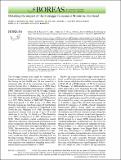Files in this item
Detailing the impact of the Storegga Tsunami at Montrose, Scotland
Item metadata
| dc.contributor.author | Bateman, Mark D. | |
| dc.contributor.author | Kinnaird, Tim C. | |
| dc.contributor.author | Hill, Jon | |
| dc.contributor.author | Ashurst, Robert A. | |
| dc.contributor.author | Mohan, Jenna | |
| dc.contributor.author | Bateman, Rebecca B. I. | |
| dc.contributor.author | Robinson, Ruth | |
| dc.date.accessioned | 2021-06-21T08:30:10Z | |
| dc.date.available | 2021-06-21T08:30:10Z | |
| dc.date.issued | 2021-06-03 | |
| dc.identifier | 274528860 | |
| dc.identifier | 2b0dbc8b-b8b9-4501-8413-d6963362f22a | |
| dc.identifier | 85107162743 | |
| dc.identifier | 000657536400001 | |
| dc.identifier.citation | Bateman , M D , Kinnaird , T C , Hill , J , Ashurst , R A , Mohan , J , Bateman , R B I & Robinson , R 2021 , ' Detailing the impact of the Storegga Tsunami at Montrose, Scotland ' , Boreas , vol. Early View . https://doi.org/10.1111/bor.12532 | en |
| dc.identifier.issn | 0300-9483 | |
| dc.identifier.other | Jisc: dcc929e3d08a4d408969557588d7f557 | |
| dc.identifier.other | publisher-id: bor12532 | |
| dc.identifier.uri | https://hdl.handle.net/10023/23396 | |
| dc.description.abstract | The Storegga tsunami, dated in Norway to 8150±30 cal. years BP, hit many countries bordering the North Sea. Run‐ups of >30 m occurred and 1000s of kilometres of coast were impacted. Whilst recent modelling successfully generated a tsunami wave train, the wave heights and velocities, it under‐estimated wave run‐ups. Work presented here used luminescence to directly date the Storegga tsunami deposits at the type site of Maryton, Aberdeenshire in Scotland. It also undertook sedimentological characterization to establish provenance, and number and relative power of the tsunami waves. Tsunami model refinement used this to better understand coastal inundation. Luminescence ages successfully date Scottish Storegga tsunami deposits to 8100±250 years. Sedimentology showed that at Montrose, three tsunami waves came from the northeast or east, over‐ran pre‐existing marine sands and weathered igneous bedrock on the coastal plain. Incorporation of an inundation model predicts well a tsunami impacting on the Montrose Basin in terms of replicate direction and sediment size. However, under‐estimation of run‐up persisted requiring further consideration of palaeotopography and palaeo‐near‐shore bathymetry for it to agree with sedimentary evidence. Future model evolution incorporating this will be better able to inform on the hazard risk and potential impacts for future high‐magnitude submarine generated tsunami events. | |
| dc.format.extent | 17974596 | |
| dc.language.iso | eng | |
| dc.relation.ispartof | Boreas | en |
| dc.subject | GE Environmental Sciences | en |
| dc.subject | NDAS | en |
| dc.subject | SDG 14 - Life Below Water | en |
| dc.subject.lcc | GE | en |
| dc.title | Detailing the impact of the Storegga Tsunami at Montrose, Scotland | en |
| dc.type | Journal article | en |
| dc.contributor.institution | University of St Andrews. School of Earth & Environmental Sciences | en |
| dc.identifier.doi | https://doi.org/10.1111/bor.12532 | |
| dc.description.status | Peer reviewed | en |
| dc.identifier.url | https://onlinelibrary.wiley.com/doi/10.1111/bor.12532#support-information-section | en |
This item appears in the following Collection(s)
Items in the St Andrews Research Repository are protected by copyright, with all rights reserved, unless otherwise indicated.

